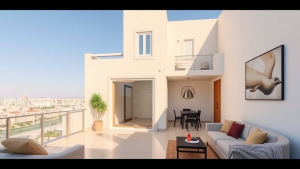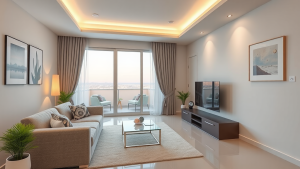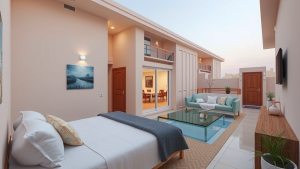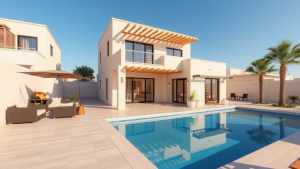Essential accessible home features for retirees on a budget
As you navigate retirement, creating a comfortable and safe living space is crucial, especially if you are budget-conscious. Several accessible home features can improve your daily life without breaking the bank. Let’s explore some essential features that cater to both accessibility and affordability.
Entryways and doorways
One of the first things to consider in an accessible home is the entrance. A few adjustments can make a significant difference:
- Ramps: If steps lead to your entrance, adding a ramp can help. Portable ramps are available and are often budget-friendly.
- Wider Doorways: Ensure that doorways are wide enough (at least 32 inches) to accommodate mobility aids like walkers or wheelchairs.
- Lever Door Handles: Replace traditional doorknobs with lever-style handles that are easier to open, especially for individuals with arthritis or limited hand strength.
Living space layout
Your living environment should promote ease of movement and accessibility. Consider these tips:
- Open Floor Plans: If you can, adapt your space to an open layout. This setup can help reduce obstacles and facilitate better flow.
- Furniture Arrangement: Arrange furniture to create clear pathways, avoiding crowded spaces to prevent accidents.
- Accessible Storage: Use shelves within easy reach to avoid climbing or stretching. Consider installing pull-out shelves or drawers for better access.
Bathroom modifications
The bathroom can be a challenging place for retirees, but simple modifications can enhance safety and accessibility:
- Grab Bars: Install grab bars next to the toilet and in the shower to provide support when moving around.
- Walk-In Showers: If possible, replace bathtubs with walk-in showers. This change minimizes the risk of slips and falls.
- Non-Slip Mats: Use non-slip mats or stickers in the shower and on tile floors to enhance safety.
Kitchen enhancements
Creating an accessible kitchen is vital for your independence. Here are a few suggestions:
- Lowered Counters: If remodeling is feasible, lower kitchen counters can make food preparation easier.
- Accessible Appliances: Choose appliances with user-friendly controls that are easy to reach. Front-loading washers and dryers are great choices for accessibility.
- Pull-Out Cabinets: pull-out shelves or lazy Susans can help you access items without strain.
Lighting and technology
Good lighting and smart technology can significantly improve safety and convenience:
- Bright Lighting: Ensure all rooms are well-lit. Use LED bulbs and consider motion-sensor lights for hallways and entrances.
- Smart Home Devices: Utilize smart technology such as voice-activated assistants for managing lights and appliances, making your home more interactive.
- Easy-to-Use Controls: Replace remote controls and light switches with larger, simplified versions to aid those with dexterity issues.
Outdoor areas
Don’t forget about outdoor space. An accessible outdoor area can enhance your living experience:
- Level Surfaces: Ensure walkways are flat and free of obstacles. Gravel or paver paths are often easier to navigate.
- Seating Areas: Create comfortable seating spots with easy access to enjoy fresh air. Consider built-in benches that provide adequate support.
- Raised Garden Beds: If you enjoy gardening, raised beds allow you to garden without bending down excessively, making it easier on your back and knees.
While achieving a fully accessible home on a budget may seem daunting, small changes can create a significant impact. Prioritizing safety and comfort will enhance your quality of life as you enter retirement. Focusing on these accessible home features allows you to create a welcoming environment that meets your needs without overspending.
Cost-effective modifications to enhance safety and comfort for seniors
Creating a safe and comfortable home environment is essential for seniors, especially for those on a budget. Many modifications can be made without breaking the bank. These enhancements not only improve safety but also promote independence and ease of daily living. Here are several cost-effective modifications that can significantly increase safety and comfort for seniors.
Lighting improvements
Good lighting is crucial for preventing falls and helping seniors navigate their homes safely. Consider the following:
- Install brighter bulbs: Switch to LED bulbs, which are energy-efficient and offer much brighter light.
- Use night lights: Place night lights in hallways, bathrooms, and bedrooms to help guide the way during night-time trips.
- Automatic timers: Install timers on outdoor lights to ensure entry points are well-lit at all times.
Bathroom safety
The bathroom can be a dangerous area due to wet surfaces. Simple modifications can enhance safety:
- Grab bars: Install grab bars near the toilet and in the shower to provide support when sitting or standing.
- Non-slip mats: Use non-slip mats in the shower and on the bathroom floor to reduce the risk of slipping.
- Shower chair: A shower chair allows seniors to sit and shower safely, reducing fatigue and the risk of falls.
Flooring adjustments
Flooring can greatly impact mobility. Consider these budget-friendly changes:
- Remove rugs: Eliminate small area rugs that can be tripped over. If keeping them, secure with non-slip backing.
- Leveling surfaces: Ensure all floor surfaces are even. Fix any raised thresholds between rooms to avoid trips.
- Carpeting considerations: If new flooring is in the budget, choose low-pile carpet for a softer surface that’s easier to walk on.
Kitchen modifications
The kitchen needs to be user-friendly to help seniors maintain independence. Some modifications include:
- Easy-access shelves: Adjust shelves to hip level or use pull-out bins for easy access to kitchen items.
- Lever-style faucets: These can be easier to use than traditional knobs, especially for those with arthritis.
- Anti-slip mats: Place anti-slip mats near the sink and stove for added stability while cooking.
Mobility aids
Enhancing mobility within the home can promote independence. Here are some options:
- Cane and walker: Encourage seniors to use canes or walkers if needed to help prevent falls.
- Stairlifts: Although a larger investment, stairlifts can be affordable and vital for navigating multi-story homes safely.
- Furniture arrangement: Create clear pathways by arranging furniture to minimize obstacles during movement.
Emergency preparedness
Being prepared for emergencies is crucial. Implement these strategies:
- Medical alert systems: These devices can quickly connect seniors with help in case of an emergency.
- Battery-operated lighting: Having flashlights and battery-operated lanterns can be critical during power outages.
- Emergency contact list: Keep a visible list of emergency contacts by the phone or on the fridge for quick access.
By making these affordable modifications, seniors can enjoy their homes with greater safety and comfort. These changes not only help prevent accidents but also allow seniors to remain independent for longer. Remember that small changes can have a big impact on overall well-being and peace of mind.
Creating a home that accommodates the needs of retirees on a budget does not have to be an overwhelming or costly endeavor. By focusing on essential accessible home features, you can significantly enhance the safety and comfort of your living space. Simple modifications such as installing grab bars in bathrooms, using non-slip flooring, and ensuring proper lighting can transform your home into a place where you can thrive during your retirement years.
Cost-effective modifications mean you don’t need to break the bank. Many adjustments, like rearranging furniture for better flow, using lever-style door handles, or adding ergonomic kitchen tools, can be implemented without a hefty price tag. These small changes can lead to a more enjoyable and secure living environment, allowing you to maintain independence while minimizing the risk of accidents.
As you assess your home, think creatively about your priorities. Reflect on your daily activities and identify areas where accessibility can be improved. Engaging family members or friends in this process can also bring innovative ideas to the table and provide moral support. By making your home more accessible, you are investing in your overall quality of life.
Ultimately, the goal is to create a space that supports your lifestyle and gives you peace of mind. Accessibility should be seen as a means to enhance your overall well-being, not simply a financial burden. With thoughtful planning and strategic modifications, your home can become a haven tailored to the unique needs of your retirement years. Embrace these changes, and enjoy the comfort and independence that come with a well-designed living space.











